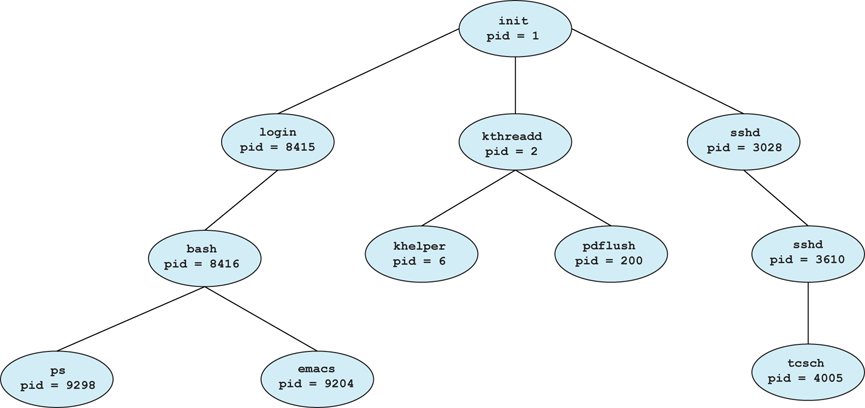3.3 Operations on Processes
3.3.1 Process Creation
- Processes may create other processes through appropriate system calls, such as fork or spawn. The process which does the creating is termed the parent of the other process, which is termed its child.
- Each process is given an integer identifier, termed its process identifier, or PID. The parent PID ( PPID ) is also stored for each process.
- On typical UNIX systems the process scheduler is termed sched, and is given PID 0. The first thing it does at system startup time is to launch init, which gives that process PID 1. Init then launches all system daemons and user logins, and becomes the ultimate parent of all other processes. Figure 3.9 shows a typical process tree for a Linux system, and other systems will have similar though not identical trees:
Figure 3.8 - A tree of processes on a typical Linux system
- Depending on system implementation, a child process may receive some amount of shared resources with its parent. Child processes may or may not be limited to a subset of the resources originally allocated to the parent, preventing runaway children from consuming all of a certain system resource.
- There are two options for the parent process after creating the child:
- Wait for the child process to terminate before proceeding. The parent makes a wait( ) system call, for either a specific child or for any child, which causes the parent process to block until the wait( ) returns. UNIX shells normally wait for their children to complete before issuing a new prompt.
- Run concurrently with the child, continuing to process without waiting. This is the operation seen when a UNIX shell runs a process as a background task. It is also possible for the parent to run for a while, and then wait for the child later, which might occur in a sort of a parallel processing operation. ( E.g. the parent may fork off a number of children without waiting for any of them, then do a little work of its own, and then wait for the children. )
- Two possibilities for the address space of the child relative to the parent:
- The child may be an exact duplicate of the parent, sharing the same program and data segments in memory. Each will have their own PCB, including program counter, registers, and PID. This is the behavior of the fork system call in UNIX.
- The child process may have a new program loaded into its address space, with all new code and data segments. This is the behavior of the spawn system calls in Windows. UNIX systems implement this as a second step, using the exec system call.
- Figures 3.10 and 3.11 below shows the fork and exec process on a UNIX system. Note that the fork system call returns the PID of the processes child to each process - It returns a zero to the child process and a non-zero child PID to the parent, so the return value indicates which process is which. Process IDs can be looked up any time for the current process or its direct parent using the getpid( ) and getppid( ) system calls respectively.
Figure 3.9 Creating a separate process using the UNIX fork( ) system call.
Figure 3.10 - Process creation using the fork( ) system call- Related man pages:
- Figure 3.12 shows the more complicated process for Windows, which must provide all of the parameter information for the new process as part of the forking process.
Figure 3.113.3.2 Process Termination
- Processes may request their own termination by making the exit( ) system call, typically returning an int. This int is passed along to the parent if it is doing a wait( ), and is typically zero on successful completion and some non-zero code in the event of problems.
- child code:
int exitCode; exit( exitCode ); // return exitCode; has the same effect when executed from main( )- parent code:
pid_t pid; int status pid = wait( &status ); // pid indicates which child exited. exitCode in low-order bits of status // macros can test the high-order bits of status for why it stopped- Processes may also be terminated by the system for a variety of reasons, including:
- The inability of the system to deliver necessary system resources.
- In response to a KILL command, or other un handled process interrupt.
- A parent may kill its children if the task assigned to them is no longer needed.
- If the parent exits, the system may or may not allow the child to continue without a parent. ( On UNIX systems, orphaned processes are generally inherited by init, which then proceeds to kill them. The UNIX nohup command allows a child to continue executing after its parent has exited. )
- When a process terminates, all of its system resources are freed up, open files flushed and closed, etc. The process termination status and execution times are returned to the parent if the parent is waiting for the child to terminate, or eventually returned to init if the process becomes an orphan. ( Processes which are trying to terminate but which cannot because their parent is not waiting for them are termed zombies. These are eventually inherited by init as orphans and killed off. Note that modern UNIX shells do not produce as many orphans and zombies as older systems used to. )



